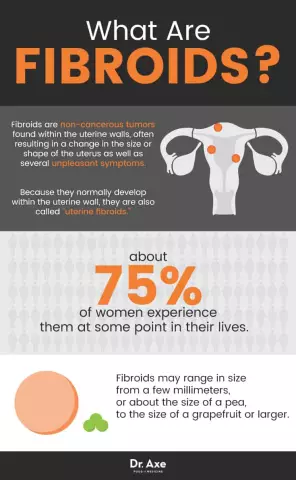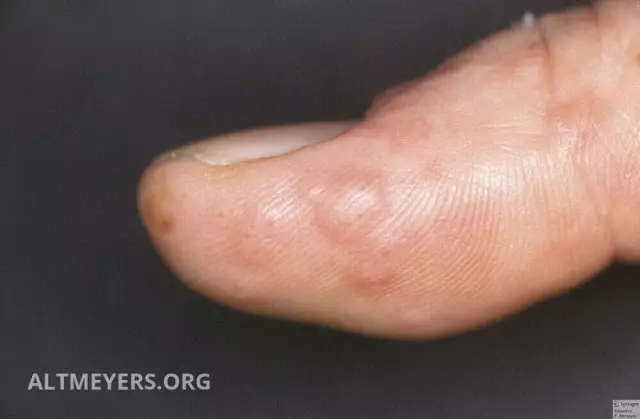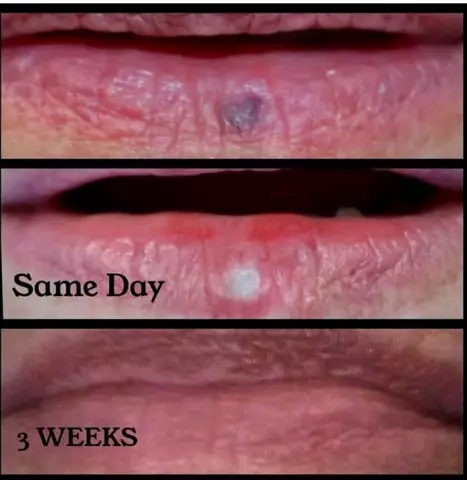- Author Rachel Wainwright [email protected].
- Public 2023-12-15 07:39.
- Last modified 2025-11-02 20:14.
Keratoconus

Keratoconus (from the Greek "karato" - cornea and "konus") - a condition of the eye in which the cornea takes a conical shape. Under the influence of degenerative processes, cells of one of the corneal layers (Bowman's layer) are destroyed, which leads to a loss of corneal rigidity, and it bulges outward under the pressure of the intraocular fluid. Keratoconus leads to severe visual impairment, but almost never leads to its complete loss.
Keratoconus is not so rare, according to medical statistics, 1 person in 2000 gets sick with it. The frequency of the disease does not depend on gender or race, the first symptoms of keratoconus appear, as a rule, in people from puberty to 20 years.
Causes of keratoconus
The reasons for the development of degenerative processes in the cornea, leading to keratoconus, are still unknown. There is no doubt the influence of autoimmune processes in which the cells of the immune system destroy the body's own cells. These data are confirmed by the fact that often keratoconus occurs in people suffering from bronchial asthma, allergies and other disorders of the immune system.
One of the factors contributing to the development of keratoconus is long-term use of corticosteroid drugs, which, among other things, has an effect on the immune system, and also confirms its leading role in the onset of the disease.
The dependence of the incidence of keratoconus on an unfavorable environmental situation, in particular, a long stay in rooms where the air is polluted with a coarse suspension of dust, causing permanent microtrauma of the cornea, was noted. There is also evidence of the influence of genetic factors on the development of the disease. In most cases, the cause of keratoconus remains unclear.
Keratoconus symptoms
As a rule, keratoconus symptoms first appear in one eye, but then the other eye is involved in the process. Keratoconus rarely occurs in only one eye, more often in different eyes there are simply different degrees of its manifestation. The main symptom of keratoconus is visual impairment. Initially, patients notice a deterioration in vision in the dark, then blurring of the image appears in good lighting. The eyes get tired quickly, sometimes they have unpleasant sensations in the form of itching or burning.
Patients with keratoconus describe the image in front of their eyes as a blurry image, which they see, as if through a glass in a heavy downpour. The image doubles, the symptom of monocular polyopia, characteristic of keratoconus, appears - when instead of one image the patient sees several. This is especially pronounced when examining light objects against a dark background. The patient is asked to look at the image of a white point on a black sheet of paper, and instead of one white point in the center, he sees several such points, chaotically scattered on the sheet of paper, and after checking this chaotic sequence does not change after a while.
The patient has difficulty in the selection of corrective glasses, there is a need for their frequent change.
Typically, the symptoms of keratoconus build up over several months or even years, then the disease stops progressing and remains at the same level for a long time. In rare cases, keratoconus progresses continuously, leading to frequent corneal tears and the threat of eye loss.
Diagnostics of the keratoconus
First, the doctor carefully asks the patient about the symptoms, then the visual acuity is checked. An examination is carried out using a slit lamp, while the detection of a symptom characteristic of keratoconus - "Fleischner's ring" is one of the diagnostic signs. Skiascopy is used - a research method in which a beam of light is directed to the iris of the patient's eye and, displacing it, monitors the reflection. With keratoconus, there is a so-called. scissor effect, in which two reflected stripes of light move like scissor blades.
One of the most informative and accurate modern methods for diagnosing keratoconus is the use of an optical topograph, with the compilation of a topographic map of the anterior and posterior walls of the cornea. This method makes it possible to diagnose keratoconus even in the early stages, and the compilation of topographic maps of the cornea at regular intervals allows observing the process in dynamics.
Keratoconus treatment

Depending on the characteristics of the process (rapid progression, a tendency to relapse, or vice versa, a slow increase in symptoms with long periods of stability), there can be both surgical and non-surgical treatment of keratoconus.
Of the conservative methods of treating keratoconus, the following are used:
- Correction with semi-rigid lenses is based on mechanical indentation of the corneal cone using special lenses, hard in the center and soft in the periphery;
- Crosslinking (Corneal Collagen Crosslinking, CCL, CXL) is a relatively new but well-proven method that allows you to strengthen the cornea and increase its rigidity by 300% in a non-surgical way. The essence of the method consists in removing the surface cells of the cornea, instilling riboflavin, followed by 30-minute irradiation of the eye with an ultraviolet lamp. Then a special contact lens is put on the eye to protect the cornea while the regeneration processes take place. Such treatment of keratoconus is safe and low-traumatic, carried out on an outpatient basis and does not require the use of general anesthesia.
In severe cases and a far advanced stage of keratoconus, the operation is still necessary, since due to frequent ruptures of the cornea there is a threat of loss of the eye. To date, there are two types of operations for keratoconus:
- Intrastromal corneal annular segments (ICS) are implanted into the cornea, thin polymer arches located on either side of the pupil, which exert constant pressure, as a result of which the cone flattens.
- Corneal transplant, or penetrating keratoplasty, is a classic method of surgery for keratoconus, when its own thinned cornea is removed, and a donor one is implanted in its place.
Treatment of keratoconus with folk remedies
In the treatment of keratoconus, folk remedies are used as fortifying, as well as prophylactic, to avoid complications of the disease, such as corneal rupture. For itching, burning and fatigue of the eyes, it is recommended to wash and lotion with decoctions of medicinal herbs such as chamomile, sage, coltsfoot. Healing herbs can also be used as teas for mild immunocorrection, such as Echinacea purpurea leaf tea.
Another of the folk remedies for the treatment of keratoconus is honey and other beekeeping products. In this case, honey and propolis are used both locally, in the form of aqueous solutions, and in food, as a fortifying and immunostimulating agent.
YouTube video related to the article:
The information is generalized and provided for informational purposes only. At the first sign of illness, see your doctor. Self-medication is hazardous to health!






